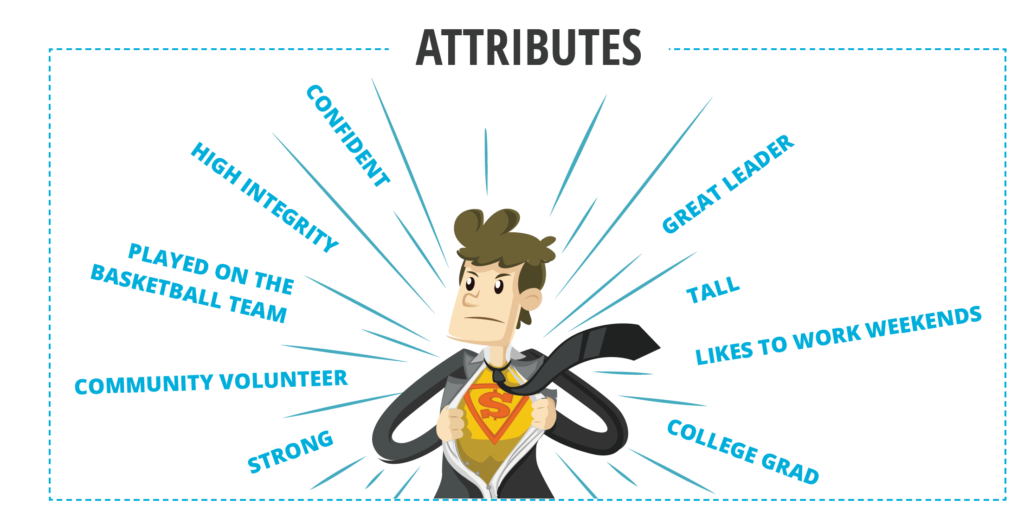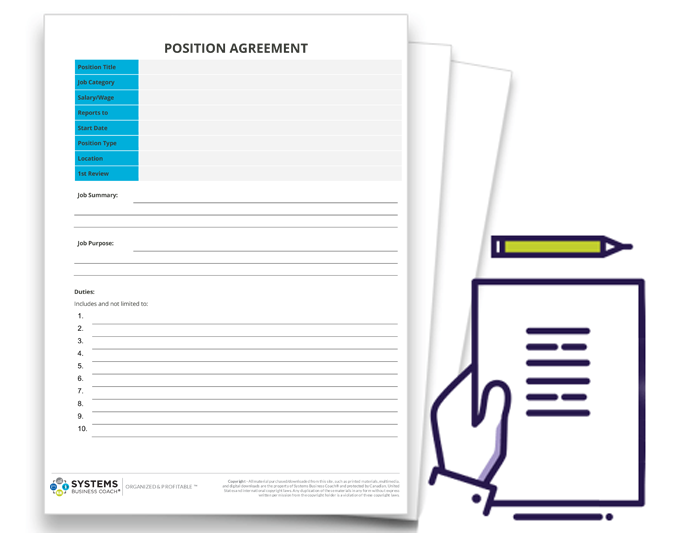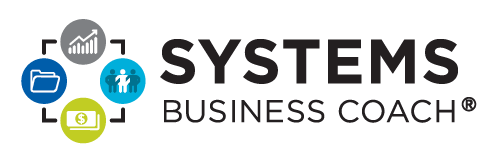***FREE Bonus Resource: Position Agreement Template***
Have you ever used these words to describe hiring someone?
- Daunting
- Difficult
- Dreadful
- Down-right awful.
It’s common for small business owners to hate hiring. Hate is a strong word. It’s true, hiring sucks. It’s like forced dating. It is emotional, time-consuming and scary. Hiring is one of your largest expenses.* And taking on the wrong person hurts your reputation. Where as hiring the right person could propel your business forward! The pressure is excruciating. But it doesn’t have to be like that.
By using the right hiring system, you can hire a reliable employee while avoiding crushing pressure and discomfort.
Like all other activities in your company, having a robust hiring system can save you time, money and drama.
By following this system, you remove the negative emotions from the process.

The 14- step hiring system.
While all organizations are unique, these are the best-practice steps you can take to have a great chance at a successful hire.
- Create a position agreement.
- Define the attributes of an ideal candidate.
- Write the job ad.
- Search for candidates.
- Sort and shortlist.
- Write 3-5 pre-interviews questions.
- Pre-interview short-list candidates with your questions.
- Conduct interviews.
- Check and double check candidates’ history and references.
- Conduct a second interview.
- Select the top two candidates.
- Use a Position Agreement and invitation letter to make an offer in writing.
- On-boarding (employment documentation)
- Welcome and orientation.
Don’t worry if you felt overwhelmed by that list. It’s a lot!
The entire process takes time and focused effort to find the right people that have both the right attitude and skill set to do the job.
I’ve had the pleasure of coaching small business owner over the last 10 years. This system is based on their needs. And I hope it will help you too!
Ready to get started?
1. Create a position agreement.
A position agreement is the foundation of your hiring system. It clearly outlines the key tasks, authorities, and responsibilities of an employee. It also ensures everyone who works for you knows your rules and is expected to play by them.
Plus, people are happier when given guidelines for their performance. In one study**, they found that the greatest rise in happiness is associated with the greatest productivity gain.
So, if you give employees guidelines to productivity from the start, it will lead them to greater happiness and motivation. Not only that, but you can rest knowing they are doing what needs to be done. Everyone is happier!
Get a FREE Position Agreement Template here.
2. Define the attributes of an ideal candidate.
When describing your ideal candidate, think of not only of the skills needed for the job, but also the attributes they need to fit in with the team.
- Are they a people-person?
- Is their sense of humour the same as ours?
- Did they play sports as a kid?
- What books have they read lately?
These questions give you an understanding of their personality.
Remember, the right person may not have the years of experience you expect. They may not have held the same job you’re hiring for or worked in the same department.
That’s okay.
A prima donna who checks all your boxes is rare.
Instead, hire for attitude and attributes.

3. Write the job ad.
This step in your hiring system comes naturally because if you did the work for steps 1 and 2, it’s already written!
Reformat your position agreement and desired attributes into an ad.
Here’s a small checklist of topics to include when reformatting your job ad:
- About your company
- Job summary
- Job purpose
- Duties
- Qualifications
- Relevant working conditions

4. Search for candidates.
Now it’s time to distribute your ad. Some great sites you can use to reach more candidates are:
5. Sort and shortlist.
To make your sorting process easier, you can use your job ad as a filtering system for the perfect hire.
For example, I recently put out an ad for a copywriter. On the ad, I asked for a small note about why the applicant would be a great person for the job. Resumes came flying in! I had 52 people apply…and only 9 included the note. That note made my sorting process easier! Instead of having to sort through 52 people, I simply looked at the 9 who wrote a note. For me, it wasn’t worth calling in anyone who didn’t pay attention to details.
Who meets your qualifications and who doesn’t?
6. Write 3-5 pre-interview questions.
Write pre-interview questions to continue filtering candidates. The questions you come up with will be relative to your needs as a business.
Here’s a few sample questions you could use:
- What is your most important contribution to your last (or current) employer?
- Describe your reputation as an employee.
- Why should our company hire you over the other finalists?
7. Pre-interview short-list candidates with your questions.
By using pre-interview questions, you cut down the quantity of full-length interviews while increasing the quality of the candidates. I recommend sending your questions out via phone or email.

8. Conduct interviews.
Once you’ve selected your stand-out candidates, start interviewing! I recommend keeping the first round of interviews to 30-60 minutes max.
One of the most important things to do during an interview is listen.
After all, how can you learn about a prospect if you’re the one doing all the talking?
9. Check and double check candidates’ history and references.
An interviewee may have really wowed you! But don’t make any promises to your candidate right away. I worked with a client whose CEO lied about having a Harvard MBA. The company didn’t check— which almost cost them the business.
Fact-check! Better to take a little extra time now than lose tons of money on a bad hire over the next several years.

10. Conduct a second interview.
The biggest trap small business owners fall into is waiting too long to hire and then having to find someone at the last minute when they are desperate.
Which makes this step enticing to brush aside. Why do a second interview when you already know who you plan on hiring?
A second interview helps you understand your potential employee and increases the chances of choosing the right hire.
Think of it like a second date. You wouldn’t go on the first date with someone, and then propose to them the next time you see them! You’d want to get to know them a little better first.
11.Select the top two candidates.
It’s finally time to select a candidate. I recommend choosing your top two and saving one for later. There are two reasons to do this:
- Your first choice might not work out, so it’s good to have a back up.
- This isn’t the only time you are going to hire. The second candidate might be perfect for the next position that opens up. Instead of starting at step 1 of this hiring system, you get to reach out to your second candidate right away.
12. Use a Position Agreement and invitation letter to make an offer in writing.
Have you ever been hired for a job and heard the employer say, “Just come in tomorrow and we’ll get you started.”? Then, they proceed to give you a quick and verbal “low-down” and suddenly you are an employee. Sound familiar?
Except, there’s a vital thing your past boss missed…they didn’t have a written offer!
Writing down your offer helps to clearly outline what the candidate is signing up for. Plus, it’s great to reference if problems arise around what your employee is hired to do.
Always write down your offer.
It’s protection for you and your employee!
Use our FREE Position Agreement Template to get started on your written offer.

13. On-boarding (employment documentation)
It’s tempting to skip this part of the hiring process. The promise of a great employee is at your fingertips. But without proper on-boarding systems, I’ve seen employers get stuck doing the new hire’s job!
Why?
Because the new hire doesn’t actually know what they are supposed to do. Then, the business owner sees an incomplete task, and instead of explaining it, they think it’s quicker to just do it themselves.
A comprehensive on-boarding process sets up your employee for success and gives you the confidence that the job is being done right.
14. Welcome and orientation.
The final step!
Think about someone coming into your home for the first time. Would you let your guest just stand there awkwardly at the front door while everyone else went about their business? Of course not!
You would greet them, introduce them to your family, show them around and make them feel welcome. It’s no different with business.
Take some time to have a one-on-one with your new employee.
Share your vision statement, company promise, house rules and how these show up in your operations.
The Importance of an Effective Hiring System
As much as I know these hiring steps will help you find someone perfect
for your company, they won’t make your hiring process fool-proof.
But, by following your hiring system, you will significantly mitigate the risk of a bad hire. And find amazing candidates that you can hire for years to come to help your company grow.
I hope these steps help you find the right person for you. You can share this blog with other small business owners who are looking to reduce the risk and relieve pressure when hiring!
Until next time, enjoy your Entrepreneurial Journey!

Share with like-minded business owners!
Looking for more hiring tips?

“The biggest trap small business owners fall into is waiting too long to hire and then having to find someone at the last minute when they are desperate.”
This trap along with the other 9 Hiring Mistakes are described in the Top 10 Hiring Mistakes (And How to Avoid Them) written specifically for small business owners.
DOWNLOAD HERE
Sources
*SHRM. (2016, August 3). Average Cost-per-Hire for Companies Is $4,129, SHRM Survey Finds [Press release]. https://www.shrm.org/about-shrm/press-room/press-releases/pages/human-capital-benchmarking-report.aspx
**SGROI, D. & Social Market Foundation. (2015, October). Happiness and productivity: Understanding the happy-productive worker. Cage: Competitive Advantage in the Global Economy. http://www.smf.co.uk/wp-content/uploads/2015/10/Social-Market-Foundation-Publication-Briefing-CAGE-4-Are-happy-workers-more-productive-281015.pdf#page=9











